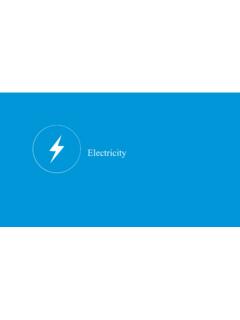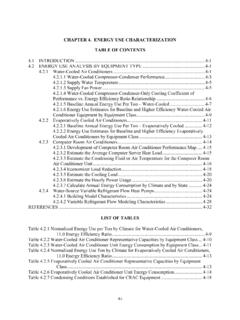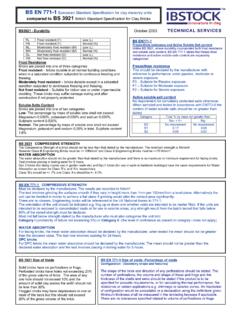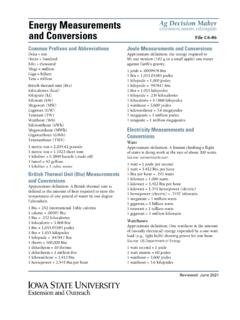Transcription of 1.4 Natural Gas Combustion - United States Environmental ...
1 Natural Gas Combustion General1-2. Natural gas is one of the major fuels used throughout the country. It is used mainly for industrial process steam and heat production; for residential and commercial space heating; and for electric power generation. Natural gas consists of a high percentage of methane (generally above 85 percent) and varying amounts of ethane, propane, butane, and inerts (typically nitrogen, carbon dioxide, and helium). Gas processing plants are required for the recovery of liquefiable constituents and removal of hydrogen sulfide before the gas is used (see Section , Natural Gas Processing). The average gross heating value of Natural gas is approximately 1020 british thermal units per standard cubic foot (Btu/scf), usually varying from 950 to 1050 Btu/scf. Firing Practices3-5. There are three major types of boilers used for Natural gas Combustion in the industrial, commercial, and utility sectors: watertube, firetube, and cast iron. Natural gas is also used in residential furnaces.
2 Watertube boilers are designed to pass water through the inside of heat transfer tubes while the outside of the tubes is heated by direct contact with the hot Combustion gases. The watertube design is the most common mechanism used for heat transfer in utility and large industrial boilers. Watertube boilers are used for a variety of applications, ranging from the provision of large amounts of process steam, to providing hot water or steam for space heating, to the generation of high-temperature, high-pressure steam for electricity production. In firetube boilers, the hot Combustion gases flow through the tubes, and the water being heated circulates outside of the tubes. These boilers are used primarily for heating systems, industrial process steam, and portable power boilers. Firetube boilers are almost exclusively packaged units. The two major types of firetube units are firebox boilers and Scotch Marine boilers. In cast iron boilers, as in firetube boilers, the hot gases are contained inside the tubes and the water being heated circulates outside the tubes.
3 However, the units are constructed of cast iron rather than steel. Virtually all cast iron boilers are constructed as package boilers. These boilers are used to produce either low-pressure steam or hot water, and are most commonly used in small commercial applications. In residential furnaces, Natural gas and air are combined in a burner and mixed to promote efficient Combustion . Combustion air is supplied by a small fan in forced air furnaces. Hot Combustion gases exchange heat with circulating air before being exhausted from a vent or chimney. A variety of burner types may be used in residential furnaces, including single port, multiport, inshot, ribbon, and slotted. Heat exchangers are typically of the sectional or drum types. Materials of construction for burners and heat exchangers include cast iron, stamped steel, and tube steel. Emissions3-4. Natural gas is considered to be one of the cleanest of the commonly used fossil fuels. The emissions from Natural gas-fired boilers and furnaces include nitrogen oxides (NOx), carbon monoxide (CO), and carbon dioxide (CO2), and trace amounts of sulfur dioxide (SO2), particulate matter (PM), organic compounds, and other greenhouse gases.
4 10/96 External Combustion Sources Nitrogen Oxides - Nitrogen oxides are the major pollutants of concern when burning Natural gas. NOx formed in Combustion processes are due either to thermal fixation of atmospheric nitrogen in the Combustion air, resulting in the formation of thermal NOx, or to the conversion of chemically bound nitrogen in the fuel, resulting in fuel NOx. Due to its characteristically low fuel nitrogen content, nearly all NOx emissions from Natural gas Combustion are thermal NOx. The formation of thermal NOx is affected by four furnace-zone factors: (1) nitrogen concentration, (2) oxygen concentration, (3) peak temperature, and (4) time of exposure at peak temperature. The emission trends due to changes in these factors are fairly consistent for all types of Natural gas-fired boilers and furnaces. Emission levels vary considerably with the type and size of combustor and with operating conditions (particularly Combustion air temperature, load, and excess air level in boilers).
5 Carbon Monoxide - The rate of CO emissions from boilers depends on the efficiency of Natural gas Combustion . In some cases, the addition of NOx control systems such as low NOx burners and flue gas recirculation (FGR) will reduce Combustion efficiency, resulting in higher CO (and trace organics) emissions relative to uncontrolled boilers. Sulfur Oxides - Emissions of SO2 from Natural gas-fired boilers are low because Natural gas typically contains less than percent sulfur. Sulfur-containing mercaptan, however, is added to Natural gas for detection purposes, leading to small amounts of SO2 emissions. Particulate Matter - Because Natural gas is a gaseous fuel, filterable particulate matter emissions are typically low. Particulate matter (PM) from Natural gas Combustion has been estimated to be less than 1 micrometer in size. Particulate matter is composed of filterable and condensable fractions, based on the EPA. Method 5. Filterable and condensable emission rates are of the same order of magnitude for boilers.
6 For residential furnaces, most of the PM is in the form of condensable material. Organics - The rate of trace organic emissions from boilers and furnaces also depends on Combustion efficiency. Organic emissions are minimized by Combustion practices that promote high Combustion temperatures, long residence times at those temperatures, and turbulent mixing of fuel and Combustion air. Trace amounts of organic species in the Natural gas fuel (e. g., ethylene and benzene) may also contribute to organic species emissions if they are not completely combusted in the boiler. Greenhouse Gases -6-11. Carbon dioxide (CO2), methane (CH4), and nitrous oxide (N2O) emissions are all produced during Natural gas Combustion . In properly tuned boilers, nearly all of the fuel carbon (99 percent) in Natural gas is converted to CO2 during the Combustion process. This conversion is relatively independent of firing configuration. Although the formation of CO acts to reduce CO2 emissions, the amount of CO produced is insignificant compared to the amount of CO2 produced.
7 The majority of the fuel carbon not converted to CO2 is due to incomplete Combustion . Formation of N2O during the Combustion process is governed by a complex series of reactions and its formation is dependent upon many factors. Formation of N2O is minimized when Combustion temperatures are kept high (above 1475oF) and excess air is kept to a minimum (less than 1 percent). EMISSION FACTORS 10/96. Methane emissions are highest during periods of low-temperature Combustion or incomplete Combustion , such as the start-up or shut-down cycle for boilers. Typically, conditions that favor formation of N2O also favor emissions of CH4. Controls4,12. NOx Controls - Currently, the two most prevalent Combustion NOx control techniques being applied to Natural gas-fired boilers (which result in characteristic changes in emission rates) are low NOx burners and flue gas recirculation. Low NOx burners reduce NOx by accomplishing the Combustion process in stages. Staging partially delays the Combustion process, resulting in a cooler flame which suppresses NOx formation.
8 The two most common types of low NOx burners being applied to Natural gas-fired boilers are staged air burners and staged fuel burners. NOx emission reductions of 40 to 85 percent (relative to uncontrolled emission levels) have been observed with low NOx burners. Other Combustion staging techniques which have been applied to Natural gas-fired boilers include low excess air, reduced air preheat, and staged Combustion (e. g., burners-out-of-service and overfire air). The degree of staging is a key operating parameter influencing NOx emission rates for these systems. In a flue gas recirculation (FGR) system, a portion of the flue gas is recycled from the stack to the burner windbox. Upon entering the windbox, the gas is mixed with Combustion air prior to being fed to the burner. The FGR system reduces NOx emissions by two mechanisms. The recycled flue gas comprises Combustion products which act as inerts during Combustion of the fuel/air mixture. This additional mass is heated in the Combustion zone, thereby lowering the peak flame temperature and reducing the amount of NOx formed.
9 To a lesser extent, FGR also reduces NOx formation by lowering the oxygen concentration in the primary flame zone. The amount of flue gas recirculated is a key operating parameter influencing NOx emission rates for these systems. Flue gas recirculation is normally used in combination with specially designed low NOx burners capable of improved flame holding. When used in combination, these techniques are capable of reducing uncontrolled NOx emissions by 60 to 90 percent. Two postcombustion technologies that may be applied to Natural gas-fired boilers to reduce NOx emissions by further amounts are selective noncatalytic reduction (SNCR) and selective catalytic reduction (SCR). The SNCR system involves injecting ammonia (or urea) into Combustion flue gases (in a specific temperature zone) to reduce NOx emission. The SCR system involves injecting NH3 in the presence of a catalyst to reduce NOx emissions. Emission factors for Natural gas Combustion in boilers and furnaces are presented in Tables , , , , and Tables in this section present emission factors on a volume basis (lb/106ft3).
10 To convert to an energy basis (lb/MMBtu), divide by a heating value of 1000 MMBtu/106ft3. For the purposes of developing emission factors, Natural gas combustors have been organized into four general categories: utility/large industrial boilers, small industrial boilers, commercial boilers, and residential furnaces. Boilers and furnaces within these categories share the same general design and operating characteristics and hence have similar emission characteristics when combusting Natural gas. The primary factor used to demarcate the individual combustor categories is heat input. Updates Since the Fifth Edition The Fifth Edition was released in January 1995. Revisions to this section since that date are summarized below. For further detail, consult the memoranda describing each supplement or the 10/96 External Combustion Sources background report for this section. These and other documents can be found on the CHIEF electronic bulletin board (919-541-5742), or on the new EFIG home page ( ).

















